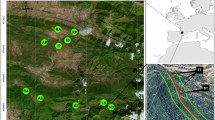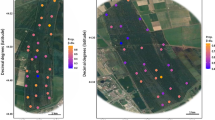Abstract
The partitioning of β-diversity is a recurrent practice in biogeographic and ecological studies that can provide key insights for land management, such as identification of biodiversity hot-spots. In this study, we used Baselga’s metrics to measure the contribution of spatial turnover (βsim) and nestedness-resultant dissimilarity (βnes) to overall β-diversity (βsor) within- and between-forest types. We analyzed a presence/absence dataset concerning 593 species of nocturnal Lepidoptera sampled within chestnut, silver fir, beech, and black pine forests of southern Italy. Ordination methods and analysis of similarities were used to assess the relative contribution of βsim and βnes to βsor, and to assess their relationships with variables linked to the experimental design and known to be determinant for insect diversity and abundance. We found that βsor was mostly due to turnover, around 98.5% in β-diversity assessment of the whole sample, and around 91% in β-diversity assessment of individual forests. Using ordination analyses based on βsim, stands were grouped according to forest type, while βnes alone was used to ordinate stands coherently with their species richness. Nevertheless, the addition of βnes to βsim produced a more ecologically coherent grouping of stands within individual forest types, and βnes alone was able to recognize patterns determined by human disturbance. In conclusion, we demonstrate that β-diversity partitioning can help to detect differences in magnitude and role of processes determining the composition of forest moth communities as in different forests the same pattern can be due to opposite processes, providing strong ecological insights into managing forest biodiversity.






Similar content being viewed by others
References
Almeida-Neto M, Frensel DMB, Ulrich W (2012) Rethinking the relationship between nestedness and beta diversity: a comment on Baselga (2010). Glob Ecol Biogeogr 21:772–777. https://doi.org/10.1111/j.1466-8238.2011.00709.x
Baselga A (2010) Partitioning the turnover and nestedness components of beta diversity. Glob Ecol Biogeogr 19:134–143. https://doi.org/10.1111/j.1466-8238.2009.00490.x
Baselga A (2012) The relationship between species replacement, dissimilarity derived from nestedness, and nestedness. Glob Ecol Biogeogr 21:1223–1232. https://doi.org/10.1111/j.1466-8238.2011.00756.x
Baselga A, Orme CDL (2012) betapart: an R package for the study of beta diversity. Methods Ecol Evol 3:808–812. https://doi.org/10.1111/j.2041-210X.2012.00224.x
Bergman K-O, Askling J, Ekberg O et al (2004) Landscape effects on butterfly assemblages in an agricultural region. Ecography 27:619–628. https://doi.org/10.1111/j.0906-7590.2004.03906.x
Canadian Centre for DNA Barcoding (2016) Description of DNA barcode protocols. In: Can. Cent. DNA Barcoding. http://ccdb.ca/resources/. Accessed 13 Jun 2019
Carvalho JC, Cardoso P, Gomes P (2012) Determining the relative roles of species replacement and species richness differences in generating beta-diversity patterns. Glob Ecol Biogeogr 21:760–771. https://doi.org/10.1111/j.1466-8238.2011.00694.x
Chaundy-Smart RFC, Smith SM, Malcolm JR, Bellocq MI (2012) Comparison of moth communities following clear-cutting and wildfire disturbance in the southern boreal forest. For Ecol Manag 270:273–281. https://doi.org/10.1016/j.foreco.2011.08.021
Choi S-W, Miller JC (2013) Species richness and abundance among macromoths: a comparison of taxonomic, temporal and spatial patterns in Oregon and South Korea. Entomol Res 43:312–321. https://doi.org/10.1111/1748-5967.12036
Clarke KR (1993) Non-parametric multivariate analyses of changes in community structure. Aust J Ecol 18:117–143. https://doi.org/10.1111/j.1442-9993.1993.tb00438.x
Clough Y, Kruess A, Kleijn D, Tscharntke T (2005) Spider diversity in cereal fields: comparing factors at local, landscape and regional scales. J Biogeogr 32:2007–2014. https://doi.org/10.1111/j.1365-2699.2005.01367.x
Colwell RK (2009) Statistical estimation of species richness and shared species from samples. Estim Version 7.5.0
Cook RR, Quinn JF (1995) The influence of colonization in nested species subsets. Oecologia 102:413–424. https://doi.org/10.1007/BF00341353
Crist TO, Peters VE (2014) Landscape and local controls of insect biodiversity in conservation grasslands: implications for the conservation of ecosystem service providers in agricultural environments. Land 3:693–718. https://doi.org/10.3390/land3030693
Dapporto L, Ramazzotti M, Fattorini S et al (2013) recluster: an unbiased clustering procedure for beta-diversity turnover. Ecography 36:1070–1075. https://doi.org/10.1111/j.1600-0587.2013.00444.x
Dapporto L, Fattorini S, Vodă R et al (2014) Biogeography of western Mediterranean butterflies: combining turnover and nestedness components of faunal dissimilarity. J Biogeogr 41:1639–1650. https://doi.org/10.1111/jbi.12315
de Castro Godinho MB, da Silva FR (2018) The influence of riverine barriers, climate, and topography on the biogeographic regionalization of Amazonian anurans. Sci Rep 8:3427. https://doi.org/10.1038/s41598-018-21879-9
Devictor V, van Swaay C, Brereton T et al (2012) Differences in the climatic debts of birds and butterflies at a continental scale. Nat Clim Chang 2:121–124. https://doi.org/10.1038/nclimate1347
Dover J, Settele J (2009) The influences of landscape structure on butterfly distribution and movement: a review. J Insect Conserv 13:3–27. https://doi.org/10.1007/s10841-008-9135-8
Fernández-Juricic E (2002) Can human disturbance promote nestedness? A case study with breeding birds in urban habitat fragments. Oecologia 131:269–278. https://doi.org/10.1007/s00442-002-0883-y
Ferrier S (2002) Mapping spatial pattern in biodiversity for regional conservation planning: where to from here? Syst Biol 51:331–363. https://doi.org/10.1080/10635150252899806
Gering JC, Crist TO, Veech JA (2003) Additive partitioning of species diversity across multiple spatial scales: implications for regional conservation of biodiversity. Conserv Biol 17:488–499. https://doi.org/10.1046/j.1523-1739.2003.01465.x
Greco S, Infusino M, Ienco A, Scalercio S (2018) How different management regimes of chestnut forests affect diversity and abundance of moth communities? Ann Silvic Res 42. https://doi.org/10.12899/asr-1503
Harrison S, Ross SJ, Lawton JH (1992) Beta diversity on geographic gradients in Britain. J Anim Ecol 61:151–158. https://doi.org/10.2307/5518
Infusino M, Greco S, Turco R, et al (2016) Managed mountain forests as diversity reservoirs in Mediterranean landscapes: new data on endemic species and faunistic novelties of moths. Bull Insectology 69: 249-258
Infusino M, Brehm G, Di Marco C, Scalercio S (2017) Assessing the efficiency of UV LEDs as light sources for sampling the diversity of macro-moths (Lepidoptera). Eur J Entomol 114:25–33. https://doi.org/10.14411/eje.2017.004
Infusino M, Scalercio S (2017) The Macrolepidoptera Heterocera of silver fir woodlands in the Serre Mountains (Calabria, Italy). Lepidoptera Ital 2
Infusino M, Scalercio S (2018) The importance of beech forests as reservoirs of moth diversity in Mediterranean Basin (Lepidoptera). Fragm Entomol 50:161–170. https://doi.org/10.4081/fe.2018.294
Karp DS, Rominger AJ, Zook J, Ranganathan J, Ehrlich PR, Daily GC (2012) Intensive agriculture erodes β-diversity at large scales. Ecol Lett 15:963–970. https://doi.org/10.1111/j.1461-0248.2012.01815.x
Legendre P, Legendre LFJ (1998) Numerical ecology - second English Edition. Elsevier Science BV, Amsterdam
Oksanen J, Blanchet FG, Kindt R, et al (2015) Vegan: community ecology package. R package version 2.0-10. 2013
Patterson BD, Atmar W (1986) Nested subsets and the structure of insular mammalian faunas and archipelagos. Biol J Linn Soc 28:65–82. https://doi.org/10.1111/j.1095-8312.1986.tb01749.x
Piovesan G, Biondi F, Bernabei M et al (2005) Spatial and altitudinal bioclimatic zones of the Italian peninsula identified from a beech (Fagus sylvatica L.) tree-ring network. Acta Oecol 27:197–210. https://doi.org/10.1016/j.actao.2005.01.001
Qian H, Ricklefs RE, White PS (2005) Beta diversity of angiosperms in temperate floras of eastern Asia and eastern North America. Ecol Lett 8:15–22. https://doi.org/10.1111/j.1461-0248.2004.00682.x
R Core Team (2017) R: a language and environment for statistical computing (version 3.4. 1). R Foundation for Statistical Computing, Vienna, Austria
Scalercio S, Brandmayr P, Iannotta N et al (2012) Correlations between landscape attributes and ecological traits of Lepidoptera communities in olive groves. Eur J Entomol 109:207–216. https://doi.org/10.14411/eje.2012.027
Socolar JB, Gilroy JJ, Kunin WE, Edwards DP (2016) How should beta-diversity inform biodiversity conservation? Trends Ecol Evol 31:67–80. https://doi.org/10.1016/j.tree.2015.11.005
Soininen J, Heino J, Wang J (2018) A meta-analysis of nestedness and turnover components of beta diversity across organisms and ecosystems. Glob Ecol Biogeogr 27:96–109. https://doi.org/10.1111/geb.12660
Summerville KS, Crist TO (2004) Contrasting effects of habitat quantity and quality on moth communities in fragmented landscapes. Ecography 27:3–12. https://doi.org/10.1111/j.0906-7590.2004.03664.x
van Halder I, Barbaro L, Corcket E, Jactel H (2008) Importance of semi-natural habitats for the conservation of butterfly communities in landscapes dominated by pine plantations. Biodivers Conserv 17:1149–1169. https://doi.org/10.1007/s10531-007-9264-5
Whittaker RH (1960) Vegetation of the Siskiyou mountains, Oregon and California. Ecol Monogr 30:279–338
Acknowledgments
We would like to thank the Pollino National Park, the Sila National Park, and the Serre Natural Park for allowing us to perform our study. We would also like to thank Anthony Green for assisting with the final language edit.
Funding
The work was financially supported by the Project “ALForLab” (PON03PE_00024_1), which is co-funded by the National Operational Programme for Research and Competitiveness (PON R and C) 2007–2013 through the European Regional Development Fund (ERDF) and a national resource (Revolving Fund – Cohesion Action Plan (CAP) MIUR).
Author information
Authors and Affiliations
Ethics declarations
Conflict of interest
The authors declare that they have no conflict of interest.
Research involving animals
All applicable international, national, and/or institutional guidelines for the care and use of animals were followed.
Additional information
Communicated by: Matthias Waltert
Publisher’s note
Springer Nature remains neutral with regard to jurisdictional claims in published maps and institutional affiliations.
Electronic supplementary material
Online Resource 1
Description of investigated areas. (XLSX 18 kb)
Online Resource 2
R script for simulating the processes. (TXT 7 kb)
Online Resource 3
Community matrix (“Db_PA_tot”) and environmental variables matrix (“Var_tot”). (XLSX 147 kb)
Rights and permissions
About this article
Cite this article
Ienco, A., Dapporto, L., Greco, S. et al. β-Diversity partitioning of moth communities within and between different forest types. Sci Nat 107, 8 (2020). https://doi.org/10.1007/s00114-020-1665-2
Received:
Revised:
Accepted:
Published:
DOI: https://doi.org/10.1007/s00114-020-1665-2




